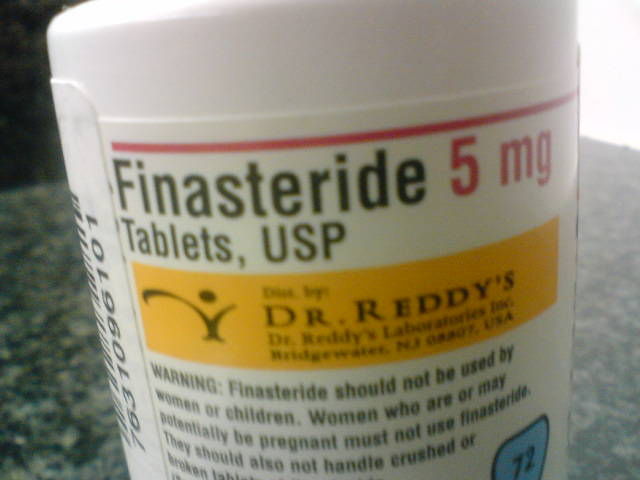Finasteride is a prescription medication approved by the U.S. Food and Drug Administration (FDA) to treat male pattern baldness (androgenetic alopecia) and benign prostatic hyperplasia (BPH). It works by lowering levels of a hormone called dihydrotestosterone (DHT), which is primarily responsible for hair loss in men.
Finasteride works by inhibiting the enzyme 5-alpha-reductase, which converts testosterone into DHT. High levels of DHT shrink hair follicles, especially in the scalp, causing thinning hair and baldness over time. By lowering DHT levels in the scalp by up to 60%, Finasteride helps to:
-Slow down hair loss
-Stop further hair follicle shrinkage
-In many cases, promote hair regrowth
A key scientific study published in the Journal of the American Academy of Dermatology (JAAD, 1998) found that finasteride 1 mg daily significantly increased hair count and improved appearance in men with androgenetic alopecia over two years.
Finasteride is considered highly effective for many men. In clinical trials:
Around 83% of men stopped further hair loss after 2 years.
About 66% of men experienced visible hair regrowth.
Results can start to show in 3 to 6 months, but full benefits may take up to 12 months.
Source: Kaufman et al., 1998, JAAD; Olsen et al., 2002
Finasteride is FDA-approved for use in adult men (18 and older) with male pattern hair loss. It is not recommended for:
-Women (especially pregnant women, due to risks of birth defects)
-Children
-Men with a known allergy to Finasteride or similar medications
Yes. In fact, combining Finasteride (oral) with Minoxidil (topical) is considered one of the most effective treatments for male hair loss.
– Finasteride reduces DHT and stops miniaturization of hair follicles.
– Minoxidil improves blood flow and stimulates the follicles directly.
-A 2015 study published in Dermatologic Therapy found that combination therapy was significantly more effective than using either treatment alone.
Check our home page we have selected some of most effective products of a mixture of finasteride and minoxidil.
also check minoxidil best brands here.
Dosage: 1 mg once daily (commonly sold as Propecia or generic finasteride 1 mg)
With or without food
or Topical solution: apply twice a day 1 ml each time. spread the liquid slowly on targeted area.
Take it consistently missing doses reduces effectiveness
It must be taken long-term; stopping the medication will typically reverse the benefits within 6–12 months.
Most users tolerate Finasteride well, but side effects can occur. According to clinical studies:
Common side effects (occur in ~1-2% of users):
Decreased libido
Erectile dysfunction
Reduced ejaculate volume
Less common but reported:
Testicular pain
Depression or mood changes
Breast tenderness or enlargement (gynecomastia)
In most cases, side effects resolve after stopping the drug or even while continuing in some men.
Source: FDA label; McClellan et al., 1997; Amory et al., 2007
“Post-Finasteride Syndrome” (PFS) refers to a group of persistent side effects (sexual, neurological, physical) that some men claim continue after discontinuing the drug. While some individuals report lasting issues:
The FDA has not confirmed PFS as a diagnosable condition.
Studies are ongoing, and the science is not yet conclusive.
It’s believed to be very rare.
If you’re concerned, consult a healthcare provider and weigh benefits vs risks.
No. Finasteride is a treatment, not a cure. It only works as long as you continue taking it. If you stop, DHT levels will return to normal, and hair loss will likely resume within 6 to 12 months.
Yes. Finasteride has been safely used by millions of men for over two decades. Long-term studies (up to 5 years and beyond) have shown continued effectiveness and safety, with no major health risks for most users.
–Proscar Long-Term Extension Study; Roehrborn et al., 2000
Topical finasteride is considered better than oral for some users because it delivers the medication directly to the scalp, targeting hair follicles while minimizing systemic absorption. This reduces the risk of side effects such as sexual dysfunction. Studies show that topical finasteride can lower DHT levels locally without significantly affecting blood hormone levels, offering a safer alternative for sensitive individuals.
Some studies suggest that Finasteride may reduce sperm count or semen volume in a small percentage of users, but this effect is usually reversible after stopping the drug.
– Not all men experience this.
– It is usually not enough to cause infertility in healthy individuals.
– If trying to conceive, consider pausing treatment temporarily.
–Source: Amory et al., Journal of Urology, 2007
In the U.S. and many other countries, yes, Finasteride requires a prescription. However, online telehealth platforms now offer easy access to licensed physicians who can prescribe Finasteride after an online consultation.
Yes. Generic Finasteride contains the same active ingredient (finasteride 1 mg) as Propecia. The FDA requires generics to be bioequivalent, meaning they work the same in the body.
– The only differences may be in fillers, coatings, or packaging.
– Generics are much more affordable.
Yes, this is possible and normal. It’s called “initial shedding” and usually happens within the first 1–3 months of treatment.
– It’s a sign the drug is working: old, weak hairs are falling out to make room for stronger regrowth.
– The shedding typically stops after a few months.
If you stop taking Finasteride:
– DHT levels will return to normal within 2 weeks.
– Hair that was preserved or regrown will start to fall out again.
– Within 6–12 months, you’ll likely return to your baseline hair loss pattern.
That’s why consistency is key.
Finasteride was initially studied for use in reducing the risk of prostate enlargement and prostate cancer. It may lower the overall risk of low-grade prostate cancer but might slightly increase the risk of high-grade prostate tumors, although this is still debated and not proven to be harmful.
Source: Prostate Cancer Prevention Trial (PCPT), 2003
Finasteride is not classified as a cancer-causing drug and is considered safe for most men.
Prices vary depending on brand, dosage, and pharmacy. On average:
– Generic Finasteride (1 mg daily): $10–$30/month
– Brand-name Propecia: $80–$150/month
– Online subscriptions may offer bundled deals and convenience
Tip: Always compare local pharmacy prices vs. online platforms.
in our home page we have set a list of most powerful and affordable finasteride products.
Inform your doctor if you:
– Have liver problems
– Are trying to have children
– Have a history of depression
– Are using other medications or supplements
Finasteride is not approved for women, especially those of childbearing age. It can cause serious birth defects if a woman is pregnant or may become pregnant.
Some doctors may prescribe it off-label to postmenopausal women, but this is rare and done with caution.


Leave a Reply